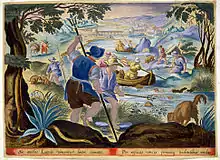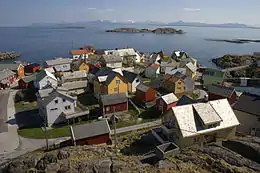Pittenweem
Pittenweem (/ˌpɪtənˈwiːm/ ![]() listen ) is a fishing village and civil parish in Fife, on the east coast of Scotland. At the 2001 census, it had a population of 1,747.
listen ) is a fishing village and civil parish in Fife, on the east coast of Scotland. At the 2001 census, it had a population of 1,747.
Pittenweem
| |
|---|---|
 Pittenweem | |
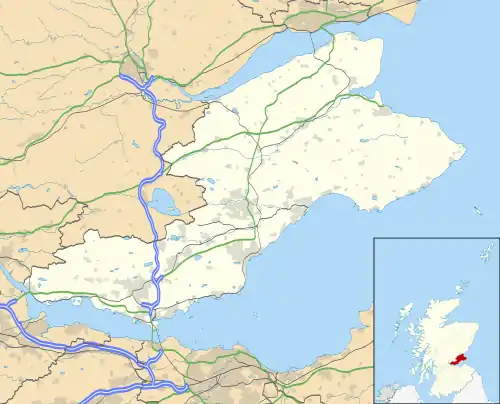 Pittenweem Location within Fife | |
| Population | 1,747 (2001) |
| OS grid reference | NO5402 |
| Council area | |
| Lieutenancy area | |
| Country | Scotland |
| Sovereign state | United Kingdom |
| Post town | ANSTRUTHER |
| Postcode district | KY10 |
| Dialling code | 01333 |
| Police | Scotland |
| Fire | Scottish |
| Ambulance | Scottish |
| UK Parliament | |
| Scottish Parliament | |
The name derives from Pictish and Scottish Gaelic. "Pit-" represents Pictish pett 'place, portion of land', and "-enweem" is Gaelic na h-Uaimh, 'of the Caves' in Gaelic, so "The Place of the Caves". The name is rendered Baile na h-Uaimh in modern Gaelic, with baile, 'town, settlement', substituted for the Pictish prefix. The cave in question is almost certainly St Fillan's cave,[1] although there are many indentations along the rocky shores that could have influenced the name.
History
The settlement has existed as a fishing village since early medieval times. The oldest structure, St. Fillan's Cave, dates from the 7th century. An Augustinian priory moved here from the Isle of May in the 13th century, but there was already a church at that time. The current parish church (which merges with the village tolbooth) has a Norman doorway of c,1200 within an older structure and several parts of the priory church are incorporated. The gatehouse to the east is 15th century. The priory dormitory and refectory was remodelled post-Reformation (1588) to give a new function as a manse. This building was later named the "Great House".[2]
Until 1975 Pittenweem was a royal burgh, having been awarded the status by King James V (1513–42) in 1541. Founded as a fishing village around a probably early Christian religious settlement, it grew along the shoreline from the west where the sheltered beaches were safe places for fishermen to draw their boats up out of the water. Later a breakwater was built, extending out from one of the rocky skerries that jut out south-west into the Firth of Forth like fingers. This allowed boats to rest at anchor rather than being beached, enabling larger vessels to use the port.
A new breakwater further to the east was developed over the years into a deep, safe harbour with a covered fish market. As the herring disappeared from local waters and the fishing fleet shrank, this harbour and its attendant facilities became the main harbour for the fishermen of the East Neuk of Fife.
The white houses with red roofs illustrate the classic East Neuk building style, influenced by trade with the Low Countries (Belgium and the Netherlands). The East Neuk offered natural trading ports for Dutch and Belgian captains as they sailed up past the east coast of England. These ships brought red pantiles as ballast, and the locals soon found them to be excellent roofing material. One can just make out the "crow step" [Scots: corbie-steppit] gable: the gable ends rise in steps rather than the more normal smooth angled line – an architectural feature imported from the Low Countries. These and other vernacular features are common throughout the town, which has one of Scotland's best-preserved and most attractive townscapes, with many historic buildings (some restored by the National Trust for Scotland). The 'organic' layout of the town centre grew up piecemeal over several centuries, with numerous winding streets and alleys.
At the shore end of the outer harbour wall, some of the paving stones have numbers engraved on them. The numbers are now randomly scattered, but once were vital to the smooth operation of the fish market. Before the pier was resurfaced, the stones were placed in numerical order at the quayside running outwards from the shore. The first fishing boat to return with its catch placed its haul alongside stone number one, the second boat at stone two and so on. When the market opened, the fish was sold in strict order of landing.

In 1779 John Paul Jones (founder of the American Navy) anchored half-a-mile off Pittenweem in the USS Bonhomme Richard. Jones bombarded Anstruther, but did not attack Pittenweem. However he made off with the town's pilot who had sailed out to meet Jones' squadron.
There is a feudal Lordship and Barony of Pittenweem created by James VI for Frederick Stewart in 1609. It was held by the Earls of Kellie until it passed to Sir John Anstruther and then to the Bairds of Elie. The current Lord Baron is Claes Zangenberg.[3]
Industry
Pittenweem is currently the most active of the fishing ports in the East Neuk coast of Fife.[4] Other primary industries are farming, tourism and, recently, arts and crafts.
In former times, Pittenweem had two coal mines, one inland at Easter Grangemuir, the other at Pathhead, on the coast between Pittenweem and St Monans. A spin-off from the Pathhead mine was salt production. Receptacles below the tideline collected water that could be pumped up to salt-pans, the pans then being heated by coal fires fed from the mine to extract the salt. Evidence of the ash produced can still be seen on the coast. At one time the village was served by the Fife Coast Railway.
Geography
The village sits astride a raised beach. The lower part of the village has the harbour and the older houses. The upper part has the main shopping area, churches, school and the more recent houses.

Education
Pittenweem Primary School is a traditional village school with its own playing fields on the northern side of the older part of the village. It caters for children aged 4/5 to 11/12. Secondary education (up to ages 16, 17 or 18 depending on educational ambitions) is provided at Waid Academy in the neighbouring town of Anstruther. The nearest private educational institution is St Leonard's School in St Andrews, or the High School of Dundee.
Religion
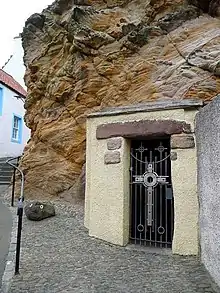
In the Middle Ages, Pittenweem Priory was a small Augustinian monastery linked to that on the Isle of May and built over the ancient sacred cave associated with St Fillan. The cave, recently fitted out as a chapel, is situated in Cove Wynd (leading from the High Street down to the harbour) and is open to the public with the key available locally from the Cocoa Tree café. From this rough dwelling St Fillan is said to have converted the local Pictish population. The cave was re-discovered around 1900 when a horse ploughing in the priory garden fell down a hole into it. The cave has flat rocks that are presumed to be 'beds' and a small spring of "holy water" at the rear. St Fillan's Cave was also used as a prison for witches during the witch hunts of the 17–18th centuries (see below).
A shrine was dedicated to St Adrian on the Isle of May. It is said that St Adrian's men undertook the first harbour improvements, laying the foundation for the fishing industry, but no evidence for this currently exists.
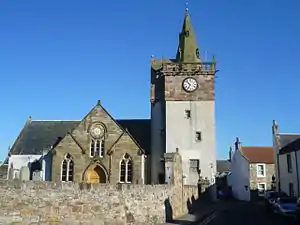
The present Church of Scotland parish kirk is on the site of the priory church. Much of the fortified east gatehouse of the priory survives (15th century), as does the 'Great House', one of Scotland's best-preserved late mediaeval houses, which may have served as accommodation for the prior and monks.
As befits a village steeped in the dangerous and uncertain practices of fishing and farming, there are many churches in the village. Current denominations with churches include: Church of Scotland, Catholic, Episcopalian and Baptist. Other denominations have had churches or the equivalent, but these have been converted to other purposes. The "Church of Scotland" Church Hall, for example, was once the "Free Church of Scotland" kirk. The Catholic church of Christ the King will be suppressed on 25 November 2018. Uniquely the village experienced the beginning of a Pentecostal denominational church primarily led by the late Evangelist, Rev. Michael C. Newlands, a converted fisherman. The movement took a more established following in the village during the 1980s. Regular services were held in a local hall, on-site of a well known building among the local community.
The late 17th to early 18th centuries saw a number of notorious witch-hunts by the local minister. The burgh was bogged down in debt and witchcraft was used as an excuse to improve the financial position by seizing the assets of some local women. The Church of Scotland building at the top of the High Street adjoined the Tolbooth which was used as the jail for some of the Pittenweem witches, and the door to the cells can still be seen. It is the studded door at the bottom of the tower.
Culture

In the late 1960s the local fishermen celebrated the re-opening of the re-designed harbour with a Gala Day, when the boats were dressed overall and people could take short trips on the boats. By the early 1980s, however, increasing regulation, higher fuel costs and a shrinking fleet were bringing this event to its knees. In its place in 1982 sprang up an Arts Festival,[5] which initially incorporated the Gala Day as its finale. The Arts Festival has moved on somewhat, however, becoming one of the best-loved art festivals in Scotland with an estimated 25,000 visitors in 2013.[6] Many artists have re-discovered the charms and the light of the area, which was always popular with itinerant and hobby artists, and have moved to the village, creating a vibrant artistic community.[7]
The village is home to a number of members of the Fence Collective, as well as the Scottish Collection of Art Extraordinary Gallery belonging to The Art Extraordinary Trust. Art Extraordinary (also known as Art Brut or outsider Art) arises from a powerful compulsion to create an inner personal vision.
Pittenweem had the first newspaper in the area – the Pittenweem Register (1844–52?). It caused a great stir in the town when the London daily newspapers contained extracts from the Register's eighth edition.
There is also a fairly well-known song, "Pittenweem Jo", written in 1960.[8]
Dolphins are often seen heading west, or east, from the KAM vantage point, where the hut never was.
Politics
The local Member of the UK Parliament (representing North East Fife) is Wendy Chamberlain of the Liberal Democrats.
The local (representing Fife North East) Member of the Scottish Parliament (MSP) is Willie Rennie of the Scottish Liberal Democrats. It is also represented by the MSPs of the Mid-Scotland and Fife parliamentary region.
Pittenweem is in the East Neuk and Landward ward of Fife council and is represented by a number of members elected by Single Transferable Vote.
From 1885–1983, Pittenweem was part of the East Fife Parliamentary constituency, its most famous MP being Prime Minister H. H. Asquith (Liberal) from 1886–1918.
Sport
The local football team is Pittenweem Rovers AFC. The local rugby team is Waid Academy FPRFC. The village also boasts a crazy putting course (open seasonal) and an outdoor tidal swimming pool at the West Braes area of the town.
Notable people
- John Douglas, Anglican Bishop of Salisbury[9]
- John Smith, clockmaker
- Ian Stewart, musician
- Frederick Stewart, Lord Pittenweem
- Sir Walter Watson Hughes, public benefactor, founder of the University of Adelaide, South Australia
- Wallace Lindsay (Wallace Martin Lindsay), classical scholar, Professor of Humanity at St Andrews University, 1899 to 1937
- Rear Admiral Taylor RN
Gallery
 West Shore, Pittenweem from the West Braes showing skerries in the foreground, the old harbour in the mid-ground and the new harbour in the background. The Isle of May (or May Island) is on the horizon.
West Shore, Pittenweem from the West Braes showing skerries in the foreground, the old harbour in the mid-ground and the new harbour in the background. The Isle of May (or May Island) is on the horizon. West Shore, Pittenweem from the West Braes
West Shore, Pittenweem from the West Braes Pittenweem swimming pool looking towards St Monans with the Lady's Tower, Elie, in the distance
Pittenweem swimming pool looking towards St Monans with the Lady's Tower, Elie, in the distance Pittenweem Harbour
Pittenweem Harbour
See also
References
- "St Fillans cave in Pittenweem". East Neuk Wide. Retrieved 13 August 2016.
- Buildings of Scotland: Fife by John Gifford
- http://baronyofpittenweem.com/reference/stories/full-grant.jpg
- "Pittenweem". Undiscovered Scotland. 2016. Retrieved 13 August 2016.
- Peebles, Cheryl (5 August 2016). "Pittenweem art festival will draw thousands to East Neuk of Fife". The Courier. Retrieved 13 August 2016.
- Peebles, Cheryl (31 July 2013). "Thousands expected at Pittenween Arts Festival". The Courier. Retrieved 13 August 2016.
- "Art Trail: Pittenweem Arts Festival". Open House Art. 2016. Retrieved 13 August 2016.
- Buchan, Norman, ed. (1962). 101 Scottish Songs. Collins. p. 88. ISBN 9780008136611.
- "Douglas, John (1721–1807), bishop of Salisbury and writer". Oxford Dictionary of National Biography. doi:10.1093/ref:odnb/9780198614128.001.0001/odnb-9780198614128-e-7908;jsessionid=906f54ba6ee11dab234a281473650745. Retrieved 27 November 2020.
| Wikimedia Commons has media related to Pittenweem. |
